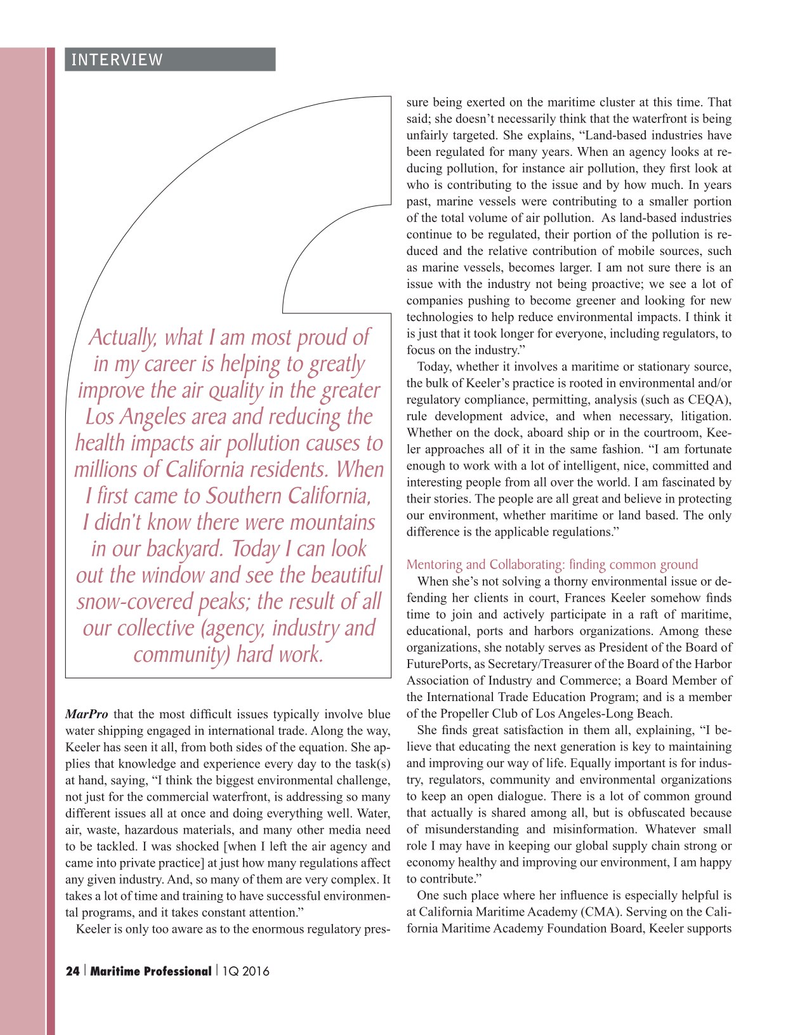
Page 24: of Maritime Logistics Professional Magazine (Q1 2016)
Maritime Training and Education
Read this page in Pdf, Flash or Html5 edition of Q1 2016 Maritime Logistics Professional Magazine
INTERVIEW sure being exerted on the maritime cluster at this time. That said; she doesn’t necessarily think that the waterfront is being unfairly targeted. She explains, “Land-based industries have been regulated for many years. When an agency looks at re- ducing pollution, for instance air pollution, they ? rst look at who is contributing to the issue and by how much. In years past, marine vessels were contributing to a smaller portion of the total volume of air pollution. As land-based industries continue to be regulated, their portion of the pollution is re- duced and the relative contribution of mobile sources, such as marine vessels, becomes larger. I am not sure there is an issue with the industry not being proactive; we see a lot of companies pushing to become greener and looking for new technologies to help reduce environmental impacts. I think it is just that it took longer for everyone, including regulators, to
Actually, what I am most proud of focus on the industry.”
Today, whether it involves a maritime or stationary source, in my career is helping to greatly the bulk of Keeler’s practice is rooted in environmental and/or improve the air quality in the greater regulatory compliance, permitting, analysis (such as CEQA), rule development advice, and when necessary, litigation.
Los Angeles area and reducing the
Whether on the dock, aboard ship or in the courtroom, Kee- health impacts air pollution causes to ler approaches all of it in the same fashion. “I am fortunate enough to work with a lot of intelligent, nice, committed and millions of California residents. When interesting people from all over the world. I am fascinated by their stories. The people are all great and believe in protecting
I ? rst came to Southern California, our environment, whether maritime or land based. The only
I didn’t know there were mountains difference is the applicable regulations.” in our backyard. Today I can look
Mentoring and Collaborating: ? nding common ground out the window and see the beautiful
When she’s not solving a thorny environmental issue or de- fending her clients in court, Frances Keeler somehow ? nds snow-covered peaks; the result of all time to join and actively participate in a raft of maritime, educational, ports and harbors organizations. Among these our collective (agency, industry and organizations, she notably serves as President of the Board of community) hard work.
FuturePorts, as Secretary/Treasurer of the Board of the Harbor
Association of Industry and Commerce; a Board Member of the International Trade Education Program; and is a member
MarPro that the most dif? cult issues typically involve blue of the Propeller Club of Los Angeles-Long Beach.
water shipping engaged in international trade. Along the way, She ? nds great satisfaction in them all, explaining, “I be-
Keeler has seen it all, from both sides of the equation. She ap- lieve that educating the next generation is key to maintaining plies that knowledge and experience every day to the task(s) and improving our way of life. Equally important is for indus- at hand, saying, “I think the biggest environmental challenge, try, regulators, community and environmental organizations not just for the commercial waterfront, is addressing so many to keep an open dialogue. There is a lot of common ground different issues all at once and doing everything well. Water, that actually is shared among all, but is obfuscated because air, waste, hazardous materials, and many other media need of misunderstanding and misinformation. Whatever small to be tackled. I was shocked [when I left the air agency and role I may have in keeping our global supply chain strong or came into private practice] at just how many regulations affect economy healthy and improving our environment, I am happy any given industry. And, so many of them are very complex. It to contribute.” takes a lot of time and training to have successful environmen- One such place where her in? uence is especially helpful is tal programs, and it takes constant attention.” at California Maritime Academy (CMA). Serving on the Cali-
Keeler is only too aware as to the enormous regulatory pres- fornia Maritime Academy Foundation Board, Keeler supports 24 Maritime Professional 1Q 2016| | 18-33 Q1 MP2016.indd 24 2/29/2016 10:44:18 AM

 23
23

 25
25
